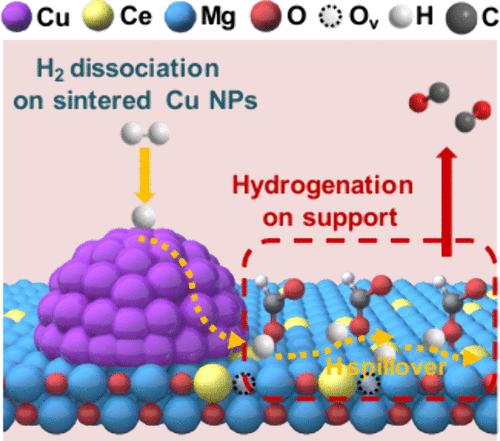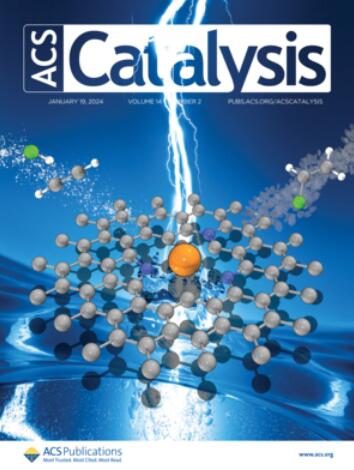Develop High-Performance Cu-Based RWGS Catalysts by Controlling Oxide–Oxide Interface
IF 11.3
1区 化学
Q1 CHEMISTRY, PHYSICAL
引用次数: 0
Abstract
The high-temperature reverse water–gas shift (RWGS) is an industrially relevant reaction. Cu-based catalysts easily sinter and deactivate under these conditions. We demonstrate that it is possible to obtain high-performance and stable catalysts by modifying the mechanism of action. Cu/CeOx-MgO (denoted as Cu/CexMgy) catalysts were developed in which Cu nanoparticles mostly generate spillover H that migrates to support sites where CO2 is selectively reduced, with the rate controlled by the oxide–oxide CeOx-MgO interface. An optimal Cu/Ce0.05Mg0.95 catalyst (in terms of performance at the lowest possible Ce amount) exhibits a near-equilibrium CO2 conversion with a reaction rate of 516.0 μmol·gcat–1·s–1, near-total selectivity to CO at 600 °C, and a high space-velocity of 300,000 mL·gcat–1·h–1. These are among the top performances in the RWGS reaction. Extensive characterization data have proven that the surface-abundant Ce-[Ov]-Mg sites play a critical role in CO2 adsorption/activation as well as the carrier for the spillover of hydrogen species. The mechanism is substantially different from those indicated for Cu-based catalysts for CO2 hydrogenation. By decoupling H and CO2 activation sites and realizing efficient surface mobility of H-spillover species via an enhanced oxide–oxide interface, it is possible to maintain the overall stability and activity of the catalyst when the Cu nanoparticles sinter at a high temperature (i.e., ≥600 °C).

求助全文
约1分钟内获得全文
求助全文
来源期刊

ACS Catalysis
CHEMISTRY, PHYSICAL-
CiteScore
20.80
自引率
6.20%
发文量
1253
审稿时长
1.5 months
期刊介绍:
ACS Catalysis is an esteemed journal that publishes original research in the fields of heterogeneous catalysis, molecular catalysis, and biocatalysis. It offers broad coverage across diverse areas such as life sciences, organometallics and synthesis, photochemistry and electrochemistry, drug discovery and synthesis, materials science, environmental protection, polymer discovery and synthesis, and energy and fuels.
The scope of the journal is to showcase innovative work in various aspects of catalysis. This includes new reactions and novel synthetic approaches utilizing known catalysts, the discovery or modification of new catalysts, elucidation of catalytic mechanisms through cutting-edge investigations, practical enhancements of existing processes, as well as conceptual advances in the field. Contributions to ACS Catalysis can encompass both experimental and theoretical research focused on catalytic molecules, macromolecules, and materials that exhibit catalytic turnover.
 求助内容:
求助内容: 应助结果提醒方式:
应助结果提醒方式:


